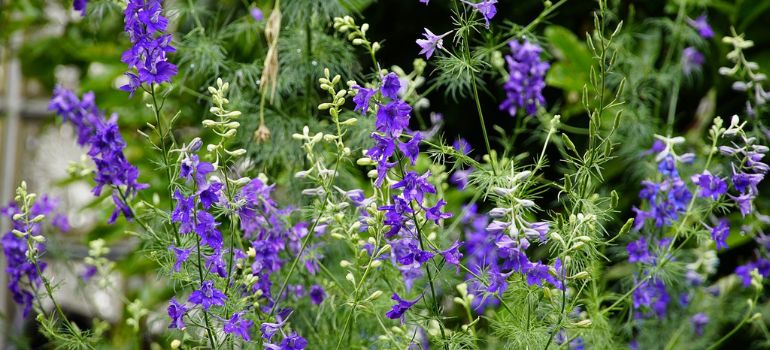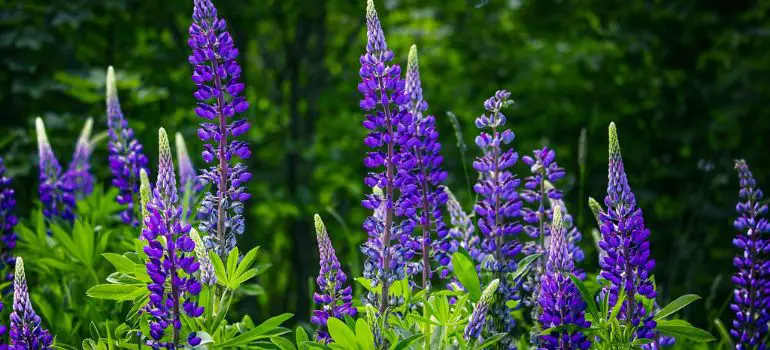Gardens are not just spaces filled with plants; they are canvases where nature paints its vibrant masterpiece. When it comes to selecting flowers for your garden, the choice between larkspur and lupine can be both exciting and perplexing. In this article, we’ll dive into the unique characteristics of these two floral wonders, exploring everything from their growth conditions to the myths surrounding them.
Introduction
Larkspur and lupine, though distinct in their features, share a common ground in their ability to elevate the aesthetics of any garden. Whether you’re an avid gardener or a landscaping enthusiast, understanding the nuances of these blooms can make a significant difference in your outdoor haven.
Larkspur Overview
Description and Characteristics: Larkspur, scientifically known as Delphinium, is a tall, elegant flower known for its spiky blooms. With a wide range of colors, including blues, pinks, and purples, larkspur adds vertical interest to any garden bed.
Varieties and Colors: There are various species of larkspur, each with its unique charm. From the classic tall larkspur to the compact dwarf varieties, the color palette is diverse, offering options for every garden theme.
Lupine Overview
Description and Characteristics: Lupine, belonging to the Lupinus genus, boasts distinctive palmate leaves and spire-like flower spikes. Available in shades of pink, purple, blue, and white, lupine is a showstopper that attracts pollinators.
Varieties and Colors: The Lupinus genus includes both annual and perennial varieties, providing flexibility in garden planning. Lupine’s range of colors allows for creative combinations and design possibilities.
Growing Conditions
Soil Requirements: Both larkspur and lupine prefer well-draining soil. However, larkspur is more tolerant of various soil types, while lupine thrives in slightly acidic to neutral soils.
Sunlight Preferences: Larkspur enjoys full sun but can tolerate partial shade, making it versatile in garden placement. Lupine, on the other hand, craves sunlight and performs best in open, sunny locations.
Watering Needs: While larkspur appreciates consistent moisture, lupine has moderate water requirements. Overwatering can be detrimental to both, so a balance is crucial for their optimal growth.
Planting and Care Tips
Best Practices for Planting Larkspur: Plant larkspur seeds in the fall or early spring, providing them with a cold period for germination. Ensure adequate spacing to prevent overcrowding, and water consistently during dry spells.
Best Practices for Planting Lupine: Lupine seeds can be directly sown in the garden or started indoors. Provide support for taller varieties, and deadhead spent blooms to encourage continuous flowering. Lupine benefits from well-drained soil.
Common Issues and Solutions: Both larkspur and lupine may face issues like powdery mildew or aphid infestations. Regular monitoring and prompt treatment with organic solutions can help keep these problems at bay.
Landscaping Ideas

Using Larkspur in Garden Design: Larkspur’s vertical growth makes it ideal for creating focal points in garden beds. Combine different colors for a striking visual impact, or plant them in clusters for a bold statement.
Incorporating Lupine for Visual Appeal: Lupine’s spire-like blooms add height and drama to any landscape. Use them as background plants to showcase shorter flowers or create a lupine border for a dynamic garden edge.
Companion Planting
Plants that Thrive Alongside Larkspur: Larkspur pairs well with companion plants like marigolds, geraniums, and daisies. The contrasting shapes and colors create a visually appealing composition.
Plants that Complement Lupine: Lupine blends seamlessly with flowers like delphiniums, salvia, and coreopsis. The varying heights and textures contribute to a balanced and harmonious garden layout.
Seasonal Blooms
When Larkspur Typically Blooms: Larkspur generally blooms in late spring to early summer. The timing may vary based on the climate and specific species, providing a prolonged display of color.
Lupine Flowering Seasons: Lupine’s flowering season varies depending on the variety. Some bloom in late spring, while others continue to flower into the summer months, ensuring continuous visual interest.
Perplexity in Plant Selection
Factors to Consider When Choosing Between Larkspur and Lupine: Consider your garden’s sunlight exposure, soil type, and the desired color palette. Larkspur’s adaptability may be preferable for certain conditions, while lupine’s bold presence may be the highlight in other settings.
Addressing Common Dilemmas: Gardeners often face the dilemma of choosing between larkspur and lupine. Understanding each plant’s requirements and envisioning your garden’s overall design can help navigate this delightful challenge.
Burstiness in Garden Aesthetics
Creating Dynamic Visual Interest with Larkspur and Lupine: Embrace burstiness by strategically placing larkspur and lupine throughout your garden. Mix complementary colors in clusters, creating focal points that capture attention and add excitement to your outdoor space.
Designing Vibrant and Diverse Landscapes: Integrate bursts of larkspur and lupine with other flowering plants, shrubs, and ornamental grasses. The resulting tapestry of colors and textures will transform your garden into a dynamic and visually stimulating haven.
Cultivating a Colorful Garden
Combining Larkspur and Lupine for a Colorful Display: Pair larkspur’s delicate spires with lupine’s bold vertical presence. Experiment with contrasting colors or create a monochromatic theme, allowing the burst of colors to captivate and inspire.
Harmonizing Contrasting Colors: Blend larkspur and lupine with flowers that have complementary hues. This harmonious integration ensures a balanced and visually appealing garden that evolves with each blooming season.
Larkspur and Lupine in Mythology
Historical and Cultural Significance: Explore the rich history and cultural symbolism associated with larkspur and lupine. From ancient myths to modern folklore, these flowers have played diverse roles in various traditions.
Symbolism in Various Traditions: Uncover the meanings behind larkspur and lupine in different cultures. Whether conveying love, protection, or spirituality, these flowers carry stories that add depth and significance to your garden.
Health Benefits of Larkspur and Lupine
Medicinal Properties, if Any: While primarily cultivated for ornamental purposes, some historical uses of larkspur and lupine in traditional medicine exist. However, caution is advised, as these plants may contain compounds that can be toxic if ingested.
Cautionary Notes for Consumption: It’s essential to highlight that larkspur and lupine are primarily grown for their visual appeal. Ingesting any part of these plants can be harmful, and precautions should be taken to keep them out of reach of children and pets.
Common Myths and Misconceptions
Dispelling Common Misunderstandings About Larkspur and Lupine: Separate fact from fiction by addressing misconceptions surrounding larkspur and lupine. From their alleged toxicity to misunderstood growing conditions, clarifying these points ensures a more informed and confident gardening experience.
Conclusion
In the delightful debate of larkspur vs. lupine, the real winner is your garden. Each flower brings its unique charm, contributing to a tapestry of colors, shapes, and stories. As you embark on your gardening journey, remember to embrace the burstiness of nature and the perplexity of choices, creating a garden that evolves with each season.
Frequently Asked Questions
Yes, larkspur and lupine can complement each other beautifully in a garden, creating a visually appealing and diverse landscape.
Both larkspur and lupine are relatively easy to care for, requiring well-draining soil, adequate sunlight, and regular watering.
While larkspur can be grown in containers, lupine’s deep root system may make it less suitable. Consider larger containers for lupine or plant them directly in the ground.
Yes, both larkspur and lupine are known to attract pollinators like bees and butterflies, contributing to a thriving garden ecosystem.
While historical uses in traditional medicine exist, it’s crucial to note that larkspur and lupine are primarily grown for ornamental purposes, and caution should be exercised regarding their potential toxicity.



